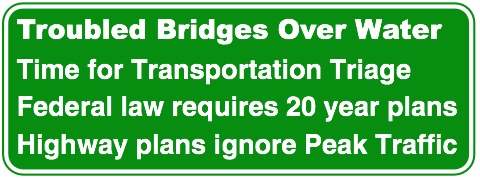Segmentation and Logical Termini
| Legal Guidelines on Termini |
"A project may be properly segmented, however, if the segments (1) have logical termini; (2) have substantial independent utility; (3) do not foreclose the opportunity to consider alternatives; and (4) do not irretrievably commit federal funds for closely related projects."
UNITED STATES COURT OF APPEALS
TENTH CIRCUIT
THOMASINE ROSS; STANLEY ROSS; ANJANETTE BITSIE; PAMINA YELLOWBIRD; JASON DANIELS; and WETLANDS PRESERVATION ORGANIZATION and KANSAS UNIVERSITY ENVIRONS, Kansas unincorporated associations,
Plaintiffs-Appellees,
v. Nos. 97-3240, 97-3278
FEDERAL HIGHWAY ADMINISTRATION; DAVID GEIGER, in his official capacity as Division Adminstrator, Federal Highway Administration; MARK BUHLER, TOM TAUL, DEAN NIEDER, in their official capacities as County Commissioners of Douglas County, Kansas; and E. DEAN CARLSON, in his official capacity as Kansas Secretary of Transportation.
Defendants-Appellants.APPEALS FROM THE UNITED STATES DISTRICT COURT
FOR THE DISTRICT OF KANSAS
(D.C. No. 97-CV-2132)
(972 F.Supp. 552)
| The Development of Logical Project Termini: FHWA Environmental Guidebook |
FHWA Environmental Guidebook:
http://www.fhwa.dot.gov/environment/guidebook/contents.htm
http://www.fhwa.dot.gov/environment/guidebook/vol2/doc12a.pdfI. Introduction
In developing a project concept which can be advanced through the stages of planning, environment, design, and construction, the project sponsor needs to consider a "whole" or integrated project. This project should satisfy an identified need, such as safety, rehabilitation, economic development, or capacity improvements, and should be considered in the context of the local area socio-economics and topography, the future travel demand, and other infrastructure improvements in the area. Without framing a project in this way, proposed improvements may miss the mark by only peripherally satisfying the need or by causing unexpected side effects which require additional corrective action. A problem of "segmentation" may also occur where a transportation need extends throughout an entire corridor but environmental issues and transportation need are inappropriately discussed for only a segment of the corridor.
The Federal Highway Administration (FHWA) regulations outline three general principles at 23 CFR 771.111(f) that are to be used to frame a highway project:In order to ensure meaningful evaluation of alternatives and to avoid commitments to transportation improvements before they are fully evaluated, the action evaluated in each (environmental impact statement] EIS or finding of no significant impact (FONSI) shall
(1) Connect logical termini and be of sufficient length to address environmental matters on a broad scope;
(2) Have independent utility or independent significance, i.e;, be usable and be a reasonable expenditure even if no additional transportation improvements-in the area are made; and
(3) Not restrict consideration of alternatives for other reasonably foreseeable transportation improvements.The aim of this paper is to discuss criteria that can be used to select logical termini (project limits) for development of a project. The primary discussion will be on the first of the three factors mentioned above. However, all three are interrelated and necessary to development of an integrated project. ...
II. A Definition of Logical Termini
Logical termini for project development are defined as (1) rational end points for a transportation improvement, and (2) rational end points for a review of the environmental impacts. The environmental impact review frequently covers a broader geographic area than the strict limits of the transportation improvements. In the past, the most common termini have been points of major traffic generation, especially intersecting roadways. This is due to the fact that in most cases traffic generators determine the size and type of facility being proposed. However, there are also cases where the project improvement is not primarily related to congestion due to traffic generators, and the choice of termini based on these generators may not be appropriate. The next section will show some examples where this is the case. .....
Choosing a corridor of sufficient length to look at all impacts need not preclude staged construction. Therefore, for a transportation corridor where the improvements are so related to one another that they should be considered one project, the termini should not be selected solely on the basis of what is programmed in a short range improvement program, but instead the several related construction projects should be evaluated as one. Construction can be programmed for shorter sections or finite construction elements as funding permits.III. Case Law
The major court case for highway projects relative to project termini involved Brackenridge Park in San Antonio, Texas (San Antonio Conservation Society Members v. Texas Highway Department and USDOT. 446 F.2d 1013 (5th Cir. 1971)). With this project, years of controversy had stalled the "North Expressway" in San Antonio, primarily because the highway would use as many as 250 acres of Brackenridge Park located in the middle section of this planned expressway. As a compromise, and to satisfy competing interests, the Secretary of Transportation had allowed the two outer sections of the road to be advertised for construction, while not approving the controversial center section. In overturning this decision, the court specifically addressed this compromise as inappropriate and as forcing eventual construction through the park in the middle segment. "Patently, the construction of these two 'end segments' to the very border, if not into, the Parklands, will make destruction of parklands inevitable, or, at least, will severely limit the number of 'feasible and prudent' alternatives to avoiding the Park."
This decision stated that project termini must be selected to ensure that environmental matters are treated on a broad scope and to prevent a highway improvement from being a "loaded gun," forcing further improvements which may have negative consequences not addressed in environmental studies. Additional urgency was given by the court to not forcing an action which would use 4(f) land.
As mentioned above, the "logical terminus criterion” is unusually elusive in these types of situations. Consequently, this case is not typical and should be referred to with caution. Nevertheless, this case is important for the determination of logical termini on highway projects for two reasons 1) while giving greater value to the independent utility criterion, it acknowledged the validity of the three criteria for evaluating alternatives and establishing termini as outlined at 23 CFR 771.111(f), and 2) it affirmed that as long as a project will serve a significant function by itself (i.e., it has independent utility), there is no requirement to include separate but related projects in the same analysis. ....V. Conclusions
The aim of this paper has not been to present all possible ways of determining logical project termini, but rather to present a thought process that can be used to make these determinations on a case by case basis. For the vast majority of highway projects, the choice of logical termini will be obvious and non-controversial. For those few major projects where other considerations are important, the termini chosen must be such that environmental issues can be treated on a sufficiently broad scope to ensure that the project will function properly without requiring additional improvements elsewhere, and the project will not restrict consideration of alternatives for other reasonably foreseeable transportation improvements.By following this guidance, proposed highway projects will be more defensible against litigation claims of project segmentation, and decision makers and the public will have a clearer picture of the transportation requirements in the project area and a better understanding of the project purpose and need.
also from the FHWA Environmental Guidebook:
CEQ's regulations regarding segmentation CEQ's NEPA regulations suggest that "[p]roposals or parts of proposals which are related to each other closely enough to be, in effect, a single course of action shall be evaluated in a single impact statement." 40 C.F.R. § 1502.4(a).
In addition, the regulations explicitly outline the circumstances under which "connected actions" are "closely related" and should be considered in a single EIS. Id. § 1508.25(a)
Specifically, CEQ's regulations provide that actions are connected if they:
In the hypothetical, construction of Segment A will not proceed unless Segment B is constructed simultaneously or previously, and vice versa. Similarly, Segments A and B are interdependent parts of a larger action (the connection of Interstate 116 and 175) and depend on that larger action for their justification. Accordingly, the construction of Segment A and Segment B should be considered in a single EIS.
- Automatically trigger other actions which may require environmental impact statements;
- Cannot or will not proceed unless other actions are taken previously or simultaneously; or
- Are interdependent parts of a larger action and depend on the larger action for their justification. Id.
FHWA's regulations regarding segmentation Since this hypothetical involves highway construction, the NEPA regulations of the Federal Highway Administration (FHWA) in the U.S.DOT are also applicable. FHWA's regulations provide that the action evaluated in an EIS shall:
23 C.F.R. § 771.111(f).
- Connect logical termini;
- Have independent utility or independent significance, i.e., be usable and be a reasonable expenditure even if no additional transportation improvements in the area are made; and
- Not restrict consideration of alternatives for other reasonably foreseeable transportation improvements."
Courts have often disapproved segmentation when the court concluded that the termini were improper, see Swain v. Brinegar, 542 F.2d 364 (7th Cir. 1976); Indian Lookout Alliance v. Volpe, 484 F.2d 11 (8th Cir. 1973); Patterson v. Exon,415 F.Supp. 1276 (D. Neb. 1976), that segments had no independent utility, or that the segments were always part of a single project for purposes of federal approval, see Named Individual Members of San Antonio Conservation Society v. Texas Highway Department, 446 F.2d 1013 (5th Cir. 1971), cert. denied, 406 U.S. 933 (1972); Appalachian Mountain Club v. Brinegar, 394 F.Supp. 105 (D.N.H. 1975). Courts have also examined the nature of a highway project, and the manner in which it was planned, to determine whether the project was improperly segmented. See, e.g. Maryland Wildlife Federation v. Lewis,560 F.Supp. 466 (D.Md. 1983); National Wildlife Federation v. Lewis, 519 F. Supp. 523 (D. Conn. 1981).
In the hypothetical above, Segment A is useless without Segment B and vice versa. Without Segment B, Segment A would extend Interstate 116 through a wilderness area and dead end at the Caroline River. Without Segment A, Segment B would extend Interstate 175 across the Caroline River and dead end in a wilderness area. Neither segment, standing alone, connects logical termini, and neither segment has independent utility or independent significance.
Segmentation questions do not arise solely in cases involving highway construction. Although courts have not adopted a single test to determine when segmentation is appropriate outside of the highway context, some trends are visible in the courts. For instance, courts often invalidate segmentation of projects when the projects are dependent on each other, see Hudson River Sloop Clearwater, Inc. v. Department of Navy, 836 F.2d 760 (2d Cir. 1988); Sierra Club v. Marsh, 769 F.2d 868 (1st Cir. 1985); City of Rochester v. United States Postal Service, 541 F.2d 967 (2d Cir. 1976); Sierra Club v. Froehlke, 534 F.2d 1289 (8th Cir. 1976), or when one project "coerces" the developer to carry out the other project, see Sadler v. 218 Housing Corp., 417 F.Supp. 348 (N.D. Ga. 1976); Citizens Against Destruction of NAPA v. Lynn, 391 F.Supp. 1188 (N.D. Cal. 1975).








